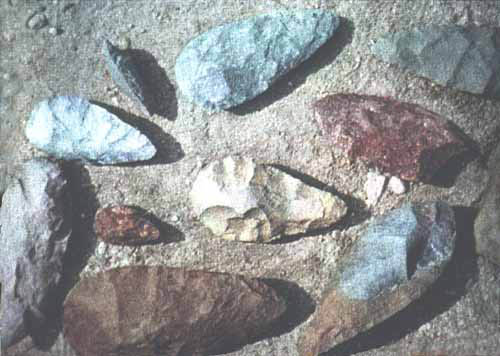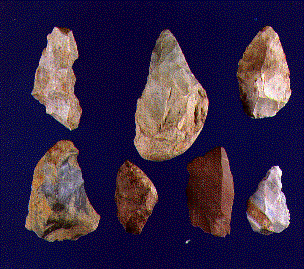|
HOME / Other Archaeological Sites / The Neolithic of the Levant Pre-History and Archaeology Glossary ProofRead and Updated April 7th 2020
Read an OUTLINE on Pre-Historic Lithic Industries FIND A WORD ON THIS PAGE: CTRL + F
ADZE: A handheld stone chipped to form a blade -- it is one of the earliest tools and was used widely in the Paleolithic and Neolithic periods.
The History of the Ancient Near East Electronic Compendium
ACHEULIAN: Old World mainly Lower Paleolithic Culture dated from 1.4 million years ago to its disappearance into the Mousterian sometime after 200,000 years ago in the Middle Paleolithic. It takes it name from Saint-Acheul in the Somme of France
ANTHROPOLOGY: The scientific and humanistic study of man's present and past biological -- linguistic -- social and cultural variations. Its major subfields are archaeology -- physical anthropology -- cultural anthropology and anthropological linguistics. ARROWHEAD: A weapon point or tip made of stone -- bone -- metal or other material usually fixed to an arrow. Larger points are regarded as spear points or knife blades.
ASYMMETRICAL: When used in reference to projectiles or tools asymmetrical refers to the opposing side of an object which has dissimilar contours -- shape or form. AURIGNACIAN: Named after the site of Aurignac in Haute-Garonne in France. This is the first culture of Homo sapiens sapiens to spread through central and western Europe at the start of the Pleniglacial Period between 40,000 and 25,000 years ago. It is characterised by the use of blade flint technology and bone tools.
AXE: A large chopping tool that may
BORER: Tools that have been retouched to a point. There is no real difference between a piercer and a borer.
BURNISHED: to make shiny or lustrous especially by rubbing (polish).
CERAMIC: Of or pertaining to pottery ..... CHATELPERRONIAN (38,000-32,000 BP): Culture named after the site of Chatelperron in Allier in France. The lithic industry produced by the Neanderthals preserved many features of the Mousterian culture from which it developed, but it also included Upper Paleolithic flake tools. CHOPPER: A river pebble or rock with varying degrees of working to obtain cutting edges. Characteristic of the first human tool industries (Homo habilis) they were pre-Acheulian but were also present in more recent pre-historic industries. CORE: A parent stone such as flint or chert from which flakes or blades have been struck and removed by percussion for use in the manufacture of tools or projectiles. CRO-MAGONONS: (Homo sapiens sapiens) The direct ancestors of modern humans who appeared about 40,000 years ago. They bore a close remblance to us with the same high brow -- prominent cheekbones and distinct chin. They are associated with the Aurignacian Culture. DEBITAGE: The by-product flakes and chips from stone tool production; it is the most abundant artifact type in prehistoric archaeological sites. DENDOCHRONOLOGY: The dating of past events or climatic changes through study of tree ring growth. DENTICULATE: Object with a finely toothed or serrated edge. DISCOID: Object having a flat circular shape.
DISTAL: The portion of a flake or blade opposite EINKORN WHEAT: Einkorn is thought to have originated in the upper area of the fertile crescent in the Near East (Tigris-Euphrates regions) and as such is the first wheat crop of the Neolithic. It is a hulled wheat that typically produces one grain per spikelet. END-SCRAPER: A lithic flake or blade somewhat thick and retouched at one end. A very common tool in the Upper Paleolithic. EPI-PALEOLITHIC: The period and cultures of Europe that came immediately after the end of the Wurm glaciation and developed for two or three thousand years. FLAKE: A thin flat asymmetrical piece of flint or other stone struck from a core. FLOTATION: An archaeological recovery method of obtaining seeds and other organic materials from soil by using liquids. GRAVETTIAN: Upper Paleolithic culture that is named after the site of La Gravette in Dordogne in France. The lithic industry is especially characterised by the Gravette point, a narrow elongated blade, one edge of which has been transformed into a back through continuous retouch. This culture followed the Aurignacian between 28,000 - 22,000 BP. HAFT: To attach a shaft or handle to a projectile or knife blade. To provide with a handle. HAND-AXE: A rather flat stone tool that has been completely worked and retouched on both faces. It is typical of industries of the Acheulian tradition and some Mousterian groups. HOLOCENE: (POST-GLACIAL) Present geological period which began about 10,000 years ago after the Pleistocene. HOMINIDS: Human beings and the other extinct species of hominids comprise the zoological family Hominidae and are one of some 200 species of the order Primates which include the chimpanzee -- gorilla -- orangutan. HOMO ERECTUS: Human species found in Africa, Europe and Asia between 1.5 million and 300,000 years ago. These humans were the first to control fire and to build habitations. HOMO HABILIS: The oldest human species yet to have been found. They were the creators of the first tools and lived between 2.5 million and 1 million years ago in eastern Africa. HOMO SAPIENS: These evolved representatives of the genus Homo appeared at least 100,000 years ago in Africa and then the Near East. Homo sapiens sapiens spread around the world approximately 40,000 years ago and reached Europe becoming what is now called Cro-Magnon man. Homo sapiens neanderthalensis is an archaic sub-species of Homo sapiens that took on individual characteristics in the Near East and Europe before gradually disappearing between 40,000 and 30,000 years ago at the onset of Cro-Magnon man. KNAP: In modern usage knap is restricted to the specific technique of percussion flaking whereby flakes are removed across an entire face or facet leaving a conchoidal fracture. LEVALLOIS TECHNIQUE: An Acheulian technique for obtaining flakes and points from a core invented by Homo Erectus.
LUNATE: A half moon or crescent shaped object. MESOLITHIC: (Middle Stone Age) A transitional period between the Paleolithic and Neolithic known as the Middle Stone Age or Epi-Paleolithic. In this period man was a hunter-gatherer but had not yet become sedentary. MICROLITH: A very small stone tool. The tendency to diminish the size of tools was particularly marked in Epi-Paleolithic and Mesolithic cultures. MICROBURIN: Micro-burins are the waste product from the manufacture of microliths. MOUSTERIAN INDUSTRY: A mainly Middle Paleolithic tool culture traditionally associated with Neanderthal man between 250,000 and 40,000 years ago. The record for the Mousterian contrasts sharply with that of the modern humans who followed. While the Neanderthals made a variety of tools in stone -- some of them quite complicated -- the lack of innovation over time is surprising from a modern perspective. For example not a single tool form existed 40,000 years ago that was not already present 150,000 years earlier. There was an almost mechanical redundancy to Mousterian tools that may imply more programmed behavior than that of later people. NEANDERTHALS: (Homo sapiens neanderthalensis) This archaic form of Homo sapiens had a short, muscular and robust physique with a sloping forehead, pronounced eyebrow ridges, projecting lower jaw and no chin. They appeared approximately 250,000 years ago in Europe and parts of Asia and disappeared sometime around 30,000 BC. They had a slightly larger brain than Cro-Magnons with whom they co-existed for as much as 10,000 years in Western Europe. NEOLITHIC: (New Stone Age) The cultural period that followed the Mesolithic. During it humans took up a more settled way of life; growing crops, domesticating animals and making pottery. OBSIDIAN: A volcanic glass that may be clear, black, brown or green in color, which is one of the finest raw materials for the chipping of stone tools. PALEOLITHIC: (Old Stone Age) Ancient cultural stage characterized by the use of rudimentary chipped stone tools. Archaeologists subdivide the Paleolithic into the (1) Lower Paleolithic (2.5 milliion-200,000 BC) (2) Middle Paleolithic (200,000-40,000 BC) and (3) Upper Paleolithic (40,000-16,000 BC) based upon the presence or absence of certain classes of stone artifacts. PLATFORM: A platform is the surface area receiving the force necessary to detach a flake or blade. PLEISTOCENE: The longest geological period of the Quaternary marking the advance and withdrawl of the ice sheets. It began about 2 million years ago and ended at the beginning of the Holocene 10,000 years ago. PLENI-GLACIAL: A phase of intense cold in the last glaciation starting about 100,000 years ago during which Homo sapiens sapiens developed in the northern hemisphere. PRESSURE-FLAKING: Pressure flaking is the process of forming an artifact by removing surplus material in the form of chips and flakes by a pressing force rather than by percussion. PRIMATES: Order of mammals including the various families of monkeys -- apes -- hominids and humans. QUATERNARY: The most recent geologic era subdidvided into two periods: the Pleistocene and the Holocene. It began nearly two million years ago. QUERN: Querns are simple carved stones used to grind corn. These have a larger slab of stone as the base. The corn is then placed on the slab and a smaller stone is used to grind the corn. These usually date to the prehistoric period. RADIOCARBON or C-14 DATING: A process that provides absolute dates by counting the radioactive decay of carbon in the remains of once living plants and animals. RETOUCH: The deliberate detachment of small flakes from a stone in order to make a tool.
SICKLE: Tools used for gathering cereal crops. The earliest sickles were made as composite tools by mounting microliths into hafts. SIDESCRAPER: A very common tool of the Mousterian culture characterized by a thick edge with scaly retouch -- useful for scraping hides -- wool or bone.
SQUAMOUS: covered with or consisting of scales. STRATIGRAPHY: The study of the successive layers of sedimentary deposits in order to establish a relative chronology for the cultures represented.
TRANCHET AXE: A prehistoric stone tool with a sharp cutting edge produced when a flake is removed at right angles to the main axis which enables the axe to be resharpened as required. TYPOLOGY: The study of and the chronological arrangement of projectile points and other lithic artifacts into separated types. WURM: The last Quaternary glaciation in Europe which ended around 10,000 BC. It was marked by alternate cold and temperate phases with many short-cold oscillations within the main divisions. |





